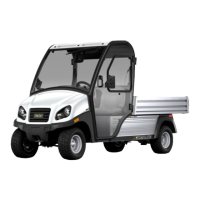
Do you have a question about the Ingersoll-Rand Club Car CARRYALL 710 LSV ELECTRIC and is the answer not in the manual?
| Brand | Ingersoll-Rand |
|---|---|
| Model | Club Car CARRYALL 710 LSV ELECTRIC |
| Category | Utility Vehicle |
| Language | English |
Importance of manual, registration, and owner communication.
Warning about chemicals and potential health effects in California.
Information on Club Car's support network and services.
Mailing address for written correspondence with Club Car.
Instructions for providing feedback on Club Car publications.
Locating and identifying vehicle model and serial numbers.
Location of the VIN and certification label.
Club Car's liability limitations and right to alter designs.
Warnings and guidelines for modifying the vehicle.
Information on where to find warranty details in the manual.
Compliance with US and Canadian safety and industry standards.
General safety guidance and warnings for vehicle operation.
Information and warnings related to vehicle safety features and hazards.
Details about safety and compliance decals on the vehicle.
Overview of safety features like interlocks, buzzers, and systems.
Instructions and warnings on correct seat belt usage and maintenance.
Safety precautions and guidelines for handling and charging batteries.
Explanation of international safety symbols related to batteries.
Information on the proper recycling of lead-acid batteries.
Diagram showing the location of various indicators and displays.
Detailed explanation of the dash display features and controls.
Information on the speedometer and how to change units (mph/kmh).
Explanation of odometer, trip meter, and hour meter functions.
Visual confirmation of the park brake engagement.
Visual indication of the selected travel direction (FNR).
Indication for low-beam and high-beam headlights.
Visual indication of turn signal and hazard light status.
Light indicating the status of battery charging.
Visual display of the battery's state of charge.
Diagram identifying all major vehicle control locations.
Function of the accelerator pedal for speed control.
Function of the brake pedal for speed reduction and stopping.
Protection for the electrical system and its reset procedure.
Controls the lifting and lowering of the cargo bed.
Sets the direction of vehicle movement (F, N, R).
Controls the operation of hazard lights.
Controls the operation of headlights.
Operation of the horn for signaling.
Controls motor and electrical system (OFF, ON, MODE2).
Engages the brake to prevent movement when parked.
Selects operation mode (Run) or maintenance/towing (Tow).
Controls the operation of turn signal lights.
Controls the operation of windshield wiper blades.
Switches for defrost, heater, and interior lights.
Controls the operation of the lower dash fan.
Controls the operation of the strobe light.
Controls the operation of the upper cab fan.
Controls the operation of the washer fluid supply.
Adjusting and securing bucket seats for safe operation.
Operation, capacity, and safety for the electric cargo bed lift.
Information on available configurations and accessories.
Operation of the tilt cargo bed and safety precautions.
Overview of the QuiQ battery charger and its benefits.
Technical specifications for the battery charger.
Compliance certifications for the battery charger.
Details on AC cord, plug, interlock, and indicator lights.
Procedures for finding algorithm numbers and inspecting cords.
Diagnostic codes and recommended solutions for charger faults.
Detailed measurements of the vehicle's length, width, height, etc.
Specifications for forward speed, turning radius, and clearance.
Information on approved wheel and tire assemblies.
Details about the motor type and horsepower rating.
Specifications for battery type and quantity.
Information on brake fluid type.
Specifications for transaxle fluid capacity.
Maximum capacities and weight limits for safe operation.
Procedures for daily checks to ensure safe operation.
Steps for conducting a thorough vehicle performance check.
Instructions for motor start, stop, forward, and reverse movement.
Precautions for various driving conditions like slopes and night.
Steps to safely disable the vehicle before maintenance.
Instructions for cleaning the windshield and exterior.
Overview and schedule for preventive maintenance tasks.
Specific tasks like brake fluid inspection and lifting the vehicle.
Procedures for safely lifting the front and rear of the vehicle.
Steps to measure and adjust tire pressure.
Procedures for removing and installing wheel assemblies.
Steps for cleaning battery tops, terminals, and removing corrosion.
Instructions for charging batteries with the onboard charger.
Procedures for disconnecting and connecting battery cables.
Ensuring battery hold-downs are tight for secure mounting.
Adding water to batteries without a SPWS.
Information on deionizer operation and maintenance.
Adding water to batteries with a SPWS.
Factors affecting watering intervals and frequency.
Importance of water purity and recommended sources.
Steps to prepare the vehicle for towing.
Precautions and guidelines for towing.
Precautions for transporting the vehicle on a trailer.
Procedures for safely removing the vehicle from a trailer.
Steps to prepare the vehicle for extended storage.
Procedures for bringing the vehicle back into service.
Details of the warranty coverage, timeframe, and items.
Conditions and damages not covered by the warranty.
Situations that will void the vehicle's warranty.
Club Car's liability and options for defective parts.
Warranty disclaimers and limitations of liability.
Limitations on claims for incidental or consequential damages.
Process for submitting a warranty claim.